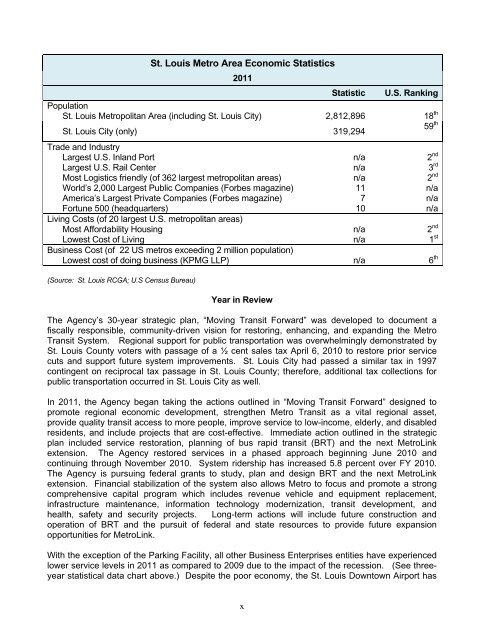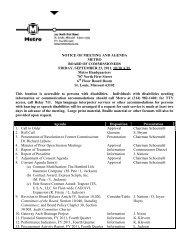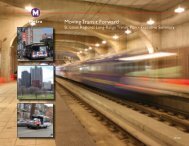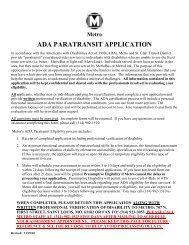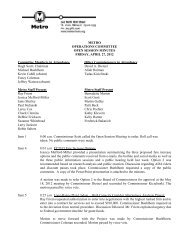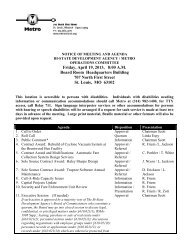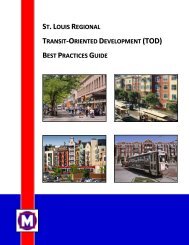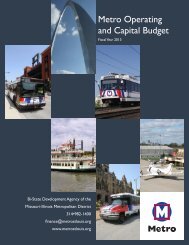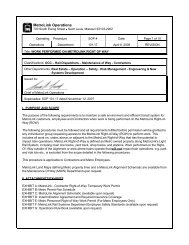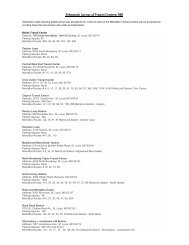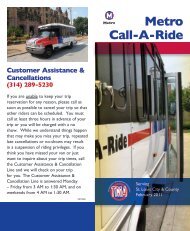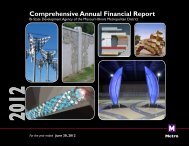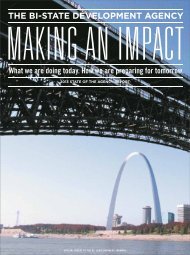Comprehensive Annual Financial Report - Metro Transit
Comprehensive Annual Financial Report - Metro Transit
Comprehensive Annual Financial Report - Metro Transit
Create successful ePaper yourself
Turn your PDF publications into a flip-book with our unique Google optimized e-Paper software.
St. Louis <strong>Metro</strong> Area Economic Statistics2011StatisticU.S. RankingPopulationSt. Louis <strong>Metro</strong>politan Area (including St. Louis City) 2,812,896 18 thSt. Louis City (only) 319,294Trade and IndustryLargest U.S. Inland Port n/a 2 ndLargest U.S. Rail Center n/a 3 rdMost Logistics friendly (of 362 largest metropolitan areas) n/a 2 ndWorld’s 2,000 Largest Public Companies (Forbes magazine) 11 n/aAmerica’s Largest Private Companies (Forbes magazine) 7 n/aFortune 500 (headquarters) 10 n/aLiving Costs (of 20 largest U.S. metropolitan areas)Most Affordability Housing n/a 2 ndLowest Cost of Living n/a 1 stBusiness Cost (of 22 US metros exceeding 2 million population)Lowest cost of doing business (KPMG LLP) n/a 6 th(Source: St. Louis RCGA; U.S Census Bureau)Year in ReviewThe Agency’s 30-year strategic plan, “Moving <strong>Transit</strong> Forward” was developed to document afiscally responsible, community-driven vision for restoring, enhancing, and expanding the <strong>Metro</strong><strong>Transit</strong> System. Regional support for public transportation was overwhelmingly demonstrated bySt. Louis County voters with passage of a ½ cent sales tax April 6, 2010 to restore prior servicecuts and support future system improvements. St. Louis City had passed a similar tax in 1997contingent on reciprocal tax passage in St. Louis County; therefore, additional tax collections forpublic transportation occurred in St. Louis City as well.In 2011, the Agency began taking the actions outlined in “Moving <strong>Transit</strong> Forward” designed topromote regional economic development, strengthen <strong>Metro</strong> <strong>Transit</strong> as a vital regional asset,provide quality transit access to more people, improve service to low-income, elderly, and disabledresidents, and include projects that are cost-effective. Immediate action outlined in the strategicplan included service restoration, planning of bus rapid transit (BRT) and the next <strong>Metro</strong>Linkextension. The Agency restored services in a phased approach beginning June 2010 andcontinuing through November 2010. System ridership has increased 5.8 percent over FY 2010.The Agency is pursuing federal grants to study, plan and design BRT and the next <strong>Metro</strong>Linkextension. <strong>Financial</strong> stabilization of the system also allows <strong>Metro</strong> to focus and promote a strongcomprehensive capital program which includes revenue vehicle and equipment replacement,infrastructure maintenance, information technology modernization, transit development, andhealth, safety and security projects. Long-term actions will include future construction andoperation of BRT and the pursuit of federal and state resources to provide future expansionopportunities for <strong>Metro</strong>Link.With the exception of the Parking Facility, all other Business Enterprises entities have experiencedlower service levels in 2011 as compared to 2009 due to the impact of the recession. (See threeyearstatistical data chart above.) Despite the poor economy, the St. Louis Downtown Airport has59 thx


